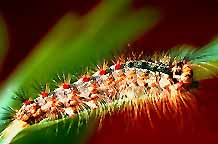
The spongy moth, Lymantria dispar, (formerly known as gypsy moth) is one of North America's most devastating invasive forest pests. The species originally evolved in Europe and Asia and has existed there for thousands of years. In the late 1860s, the spongy moth was accidentally introduced near Boston, MA by an amateur entomologist. Since then, spongy moths have spread throughout the Northeast and parts of the upper Midwest and Great Lakes states including Indiana.
The spongy moth is known to feed on the foliage of hundreds of species of trees and shrubs in North America but prefers oak trees. When spongy moth populations reach high levels, trees may be completely defoliated by feeding caterpillars. Several successive years of defoliation, along with contributions by other stress factors, often results in tree death. Spongy moth can be an expensive, messy problem for homeowners and, when out of control, can cause extensive damage to U.S. forests.
Indiana citizens can help combat this pest by understanding the spongy moth problem and learning about its management. Please use this website as a source of reliable, current information.
- Proposed Treatment Locations
The DNR is proposing treatments for spongy moth treatments at the following locations:
Mating Disruption Area
One treatment per area – Typically late June.
County
Area
Proposed Product
Huntington
Huntington Maps
- 2026 Aerial Treatment Areas Overview (PDF)
- Interactive Web Map - Select this link to open a map in a new browser window. Enter an address in the search bar on the top left of the map to find a location's proximity to the proposed treatment areas.
- Public Meetings
Representatives from the Division of Entomology & Plant Pathology will present information about spongy moth and answer questions at each of our four virtual Zoom meetings. Virtual meetings will open 15 minutes before the start time and last approximately one hour.
Virtual Meetings
Meeting Date
Meeting Times
Meeting Link
Tuesday, Jan. 27, 2026
Noon Eastern (11 a.m. Central)
https://www.zoomgov.com/j/1608152451
Meeting ID: 160 815 2451
Or join by phone at
833 568 8864 (toll-free)
6 p.m. Eastern (5 p.m. Central)
Meeting presentations and handouts
- Spongy Moth Information Presentation Video (Indiana DNR)
- Spongy Moth Presentation Handout (Indiana DNR)
- 2025 Spongy Moth Trapping Summary Maps
- Q&A’s About Using Btk to Control Spongy Moth (Purdue University)
- Q&A’s About Pheromones and Controlling Spongy Moth (Purdue University)
- SPLAT GM-Organic Frequently Asked Questions (ISCA Technologies)
- Questions and Updates
Questions about spongy moth and the proposed treatments may be directed to the Division of Entomology & Plant Pathology at:
Toll Free Number: 866-NO-EXOTIC (866-663-9684)
E-mail: DEPP@dnr.IN.govUpdates will be posted on X @INdnrinvasive throughout the planning and treatment process.
- Public Comment
The public can send comments on the proposed treatments in writing to the address below. The comment period ends Friday, Feb. 27, 2026 at 4 p.m. ET.
Mail to:
Spongy Moth 2026
Indiana DNR, Division of Entomology & Plant Pathology
402 W. Washington St., W-290
Indianapolis, IN 46204-2739E-mail: DEPP@dnr.IN.gov (Use the subject line “2026 Spongy Moth Comment”)
- Spongy Moth Treatment Product Labels & SDS sheets
- Environmental Assessment Documents
Cooperative Slow the Spread Spongy Moth Project (Coming Soon)
- Environmental Assessment
- Economic Analysis
- Decision Notice
- Project Work and Safety Plan
- Analysis of Spongy Moth Populations
Links
- Slow The Spread
This nonprofit organization was established for the purpose of aiding in the implementation of the National Slow the Spread Project. The project is part of the USDA's national strategy for the spongy moth management. - Purdue Entomology Spongy Moth Site
This web site provides information on the biology of the spongy moth, what homeowners can do to lessen the effects of the insect, and access to brochures on treatments. - Indiana's Strategic Plan for Spongy Moth
- Map of Indiana Quarantined Counties (Updated July 2023)
